Groupcast Sidelink Csi-rs With Selective Csi Reports
TAHERZADEH BOROUJENI; Mahmoud ; et al.
U.S. patent application number 17/007349 was filed with the patent office on 2021-03-18 for groupcast sidelink csi-rs with selective csi reports. The applicant listed for this patent is QUALCOMM Incorporated. Invention is credited to Sony AKKARAKARAN, Hong CHENG, Kapil GULATI, Junyi LI, Tao LUO, Juan MONTOJO, Jung Ho RYU, Mahmoud TAHERZADEH BOROUJENI.
| Application Number | 20210083819 17/007349 |
| Document ID | / |
| Family ID | 1000005066159 |
| Filed Date | 2021-03-18 |
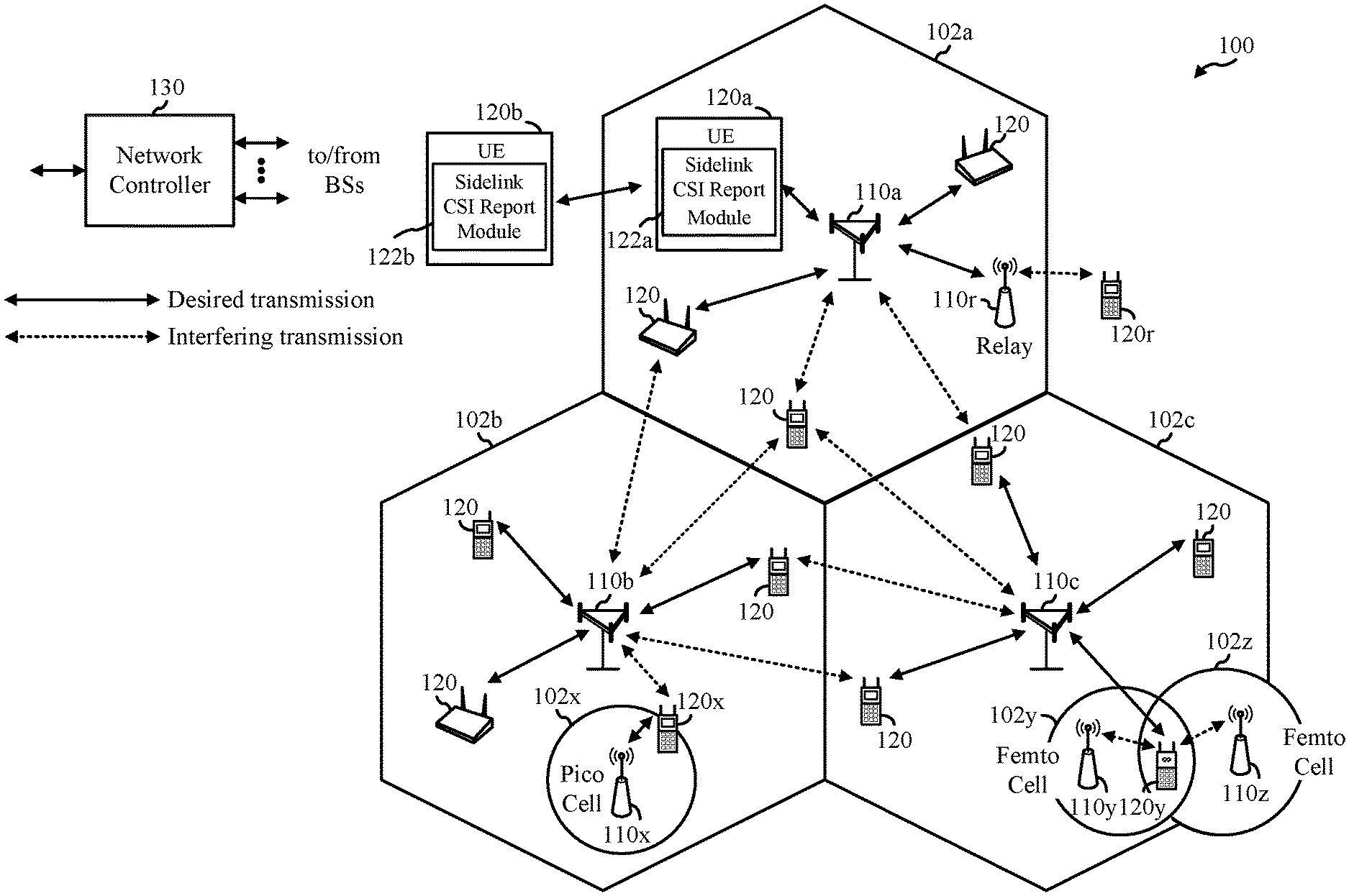
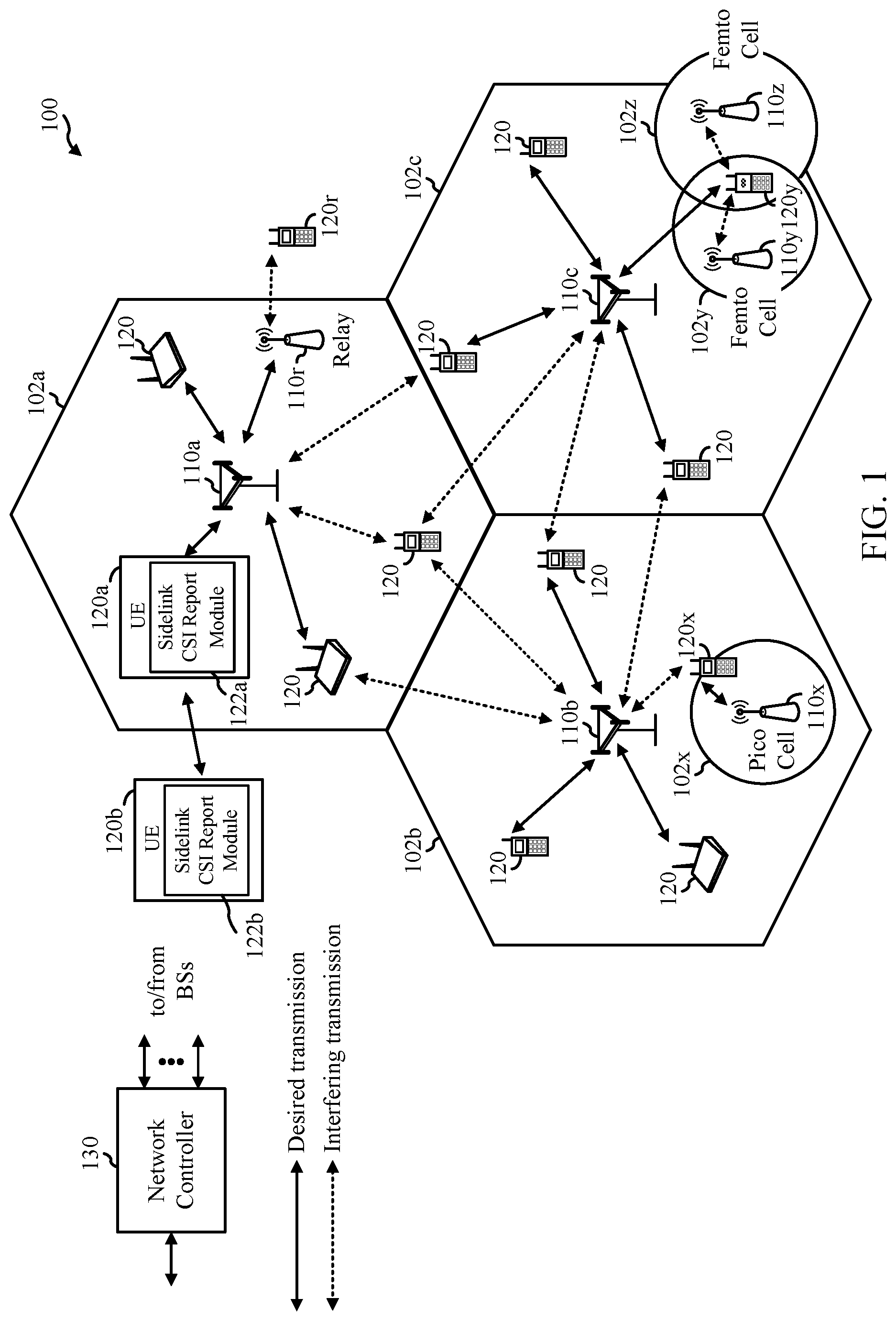
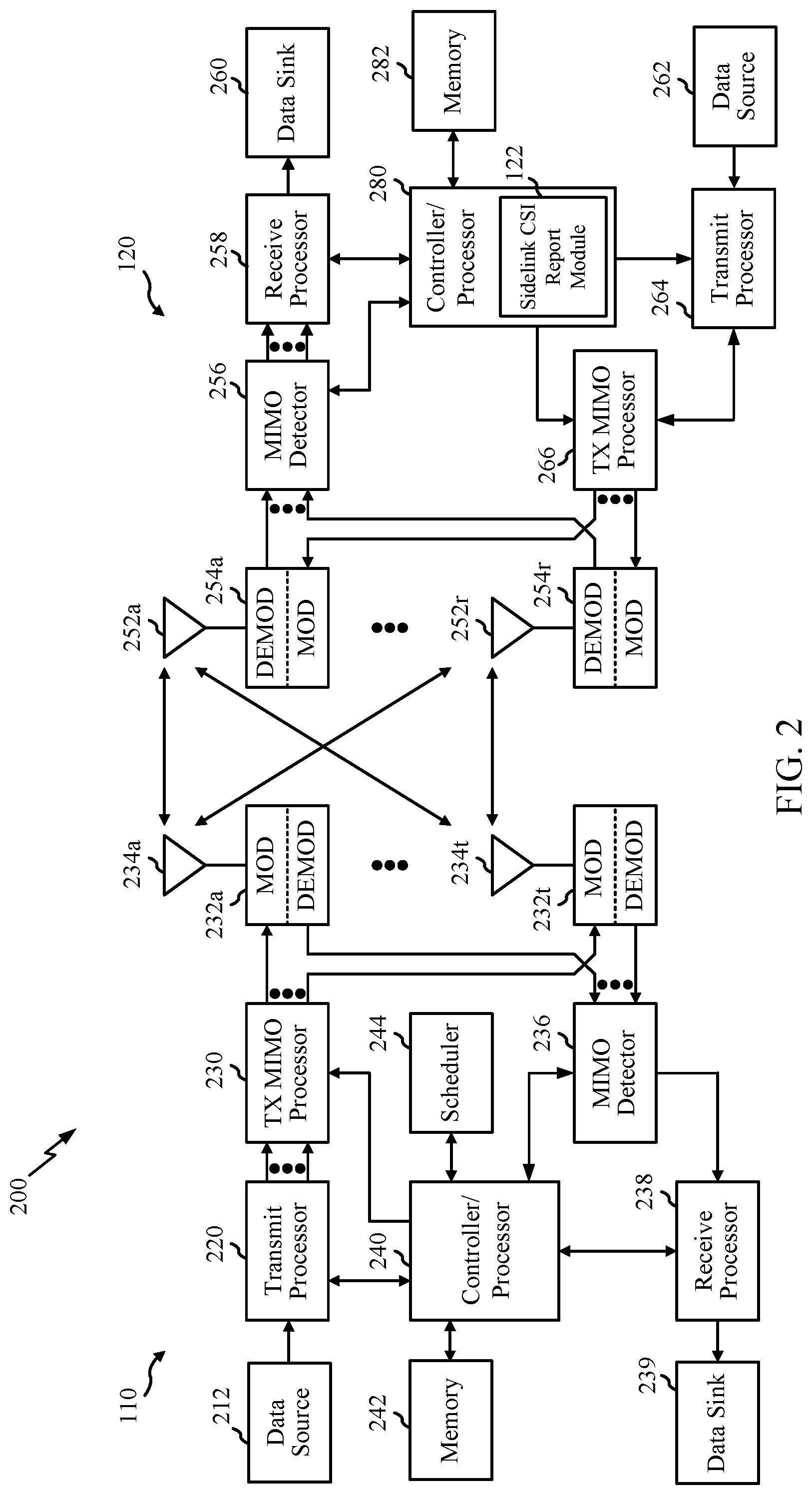
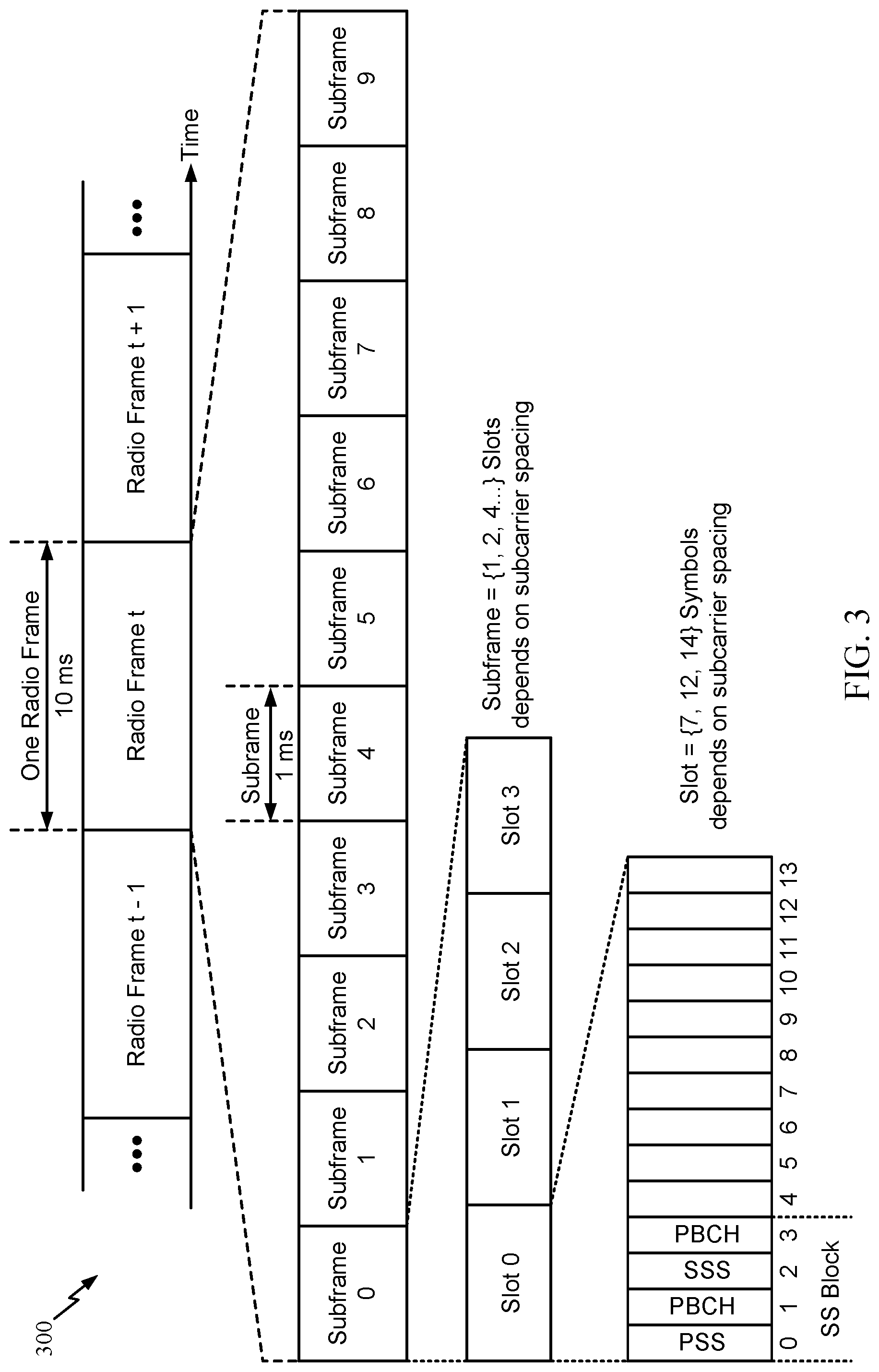
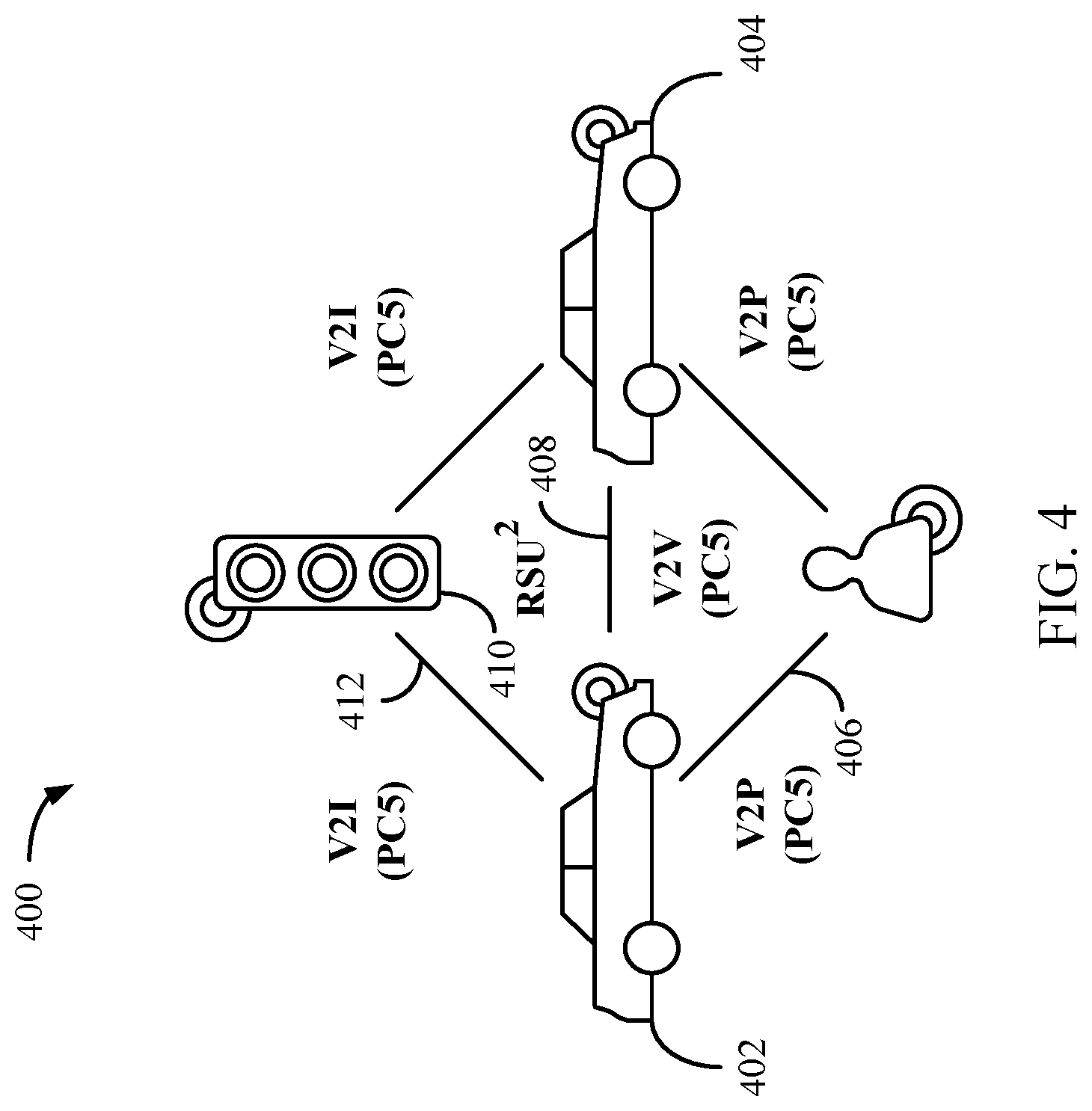
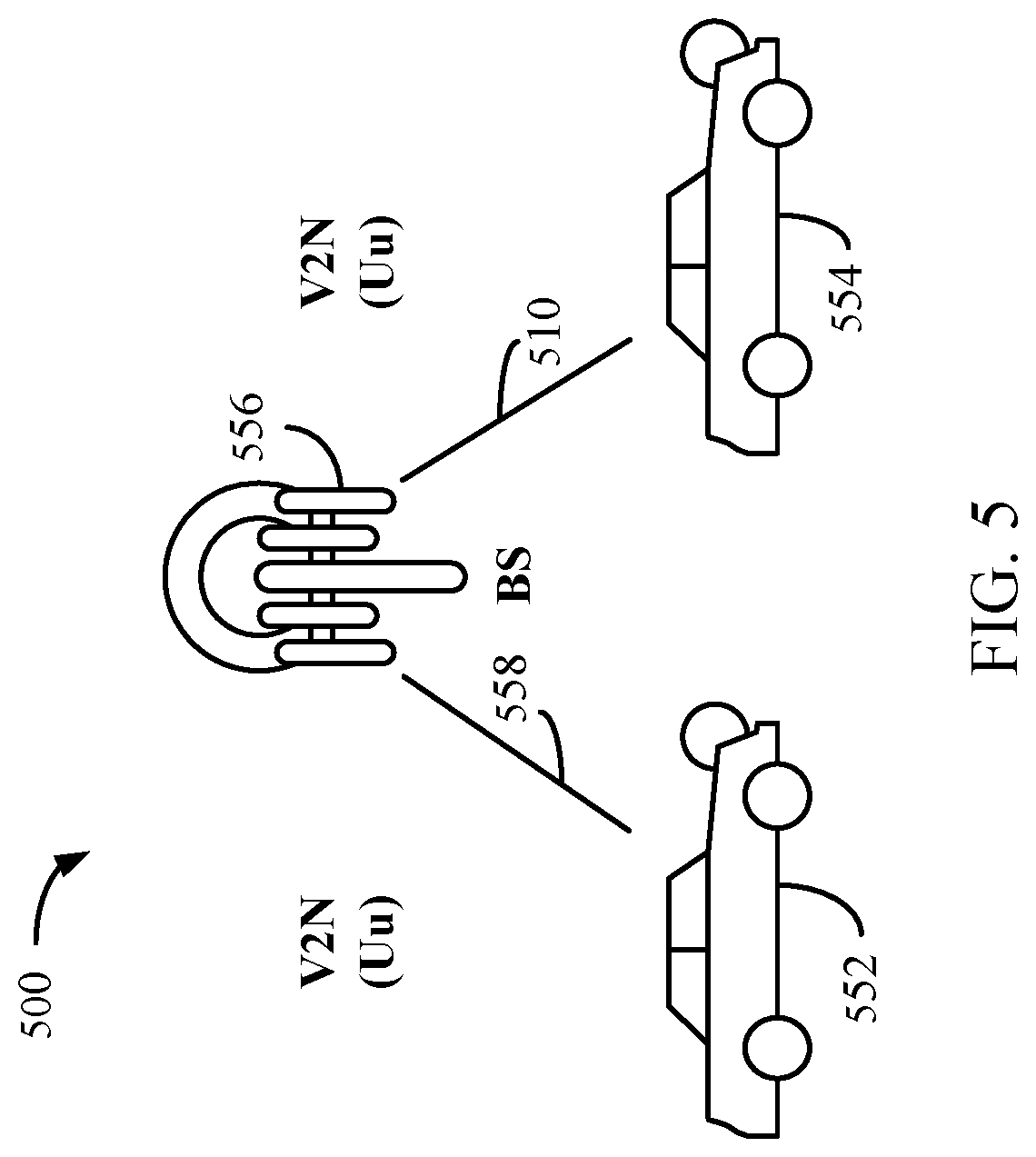
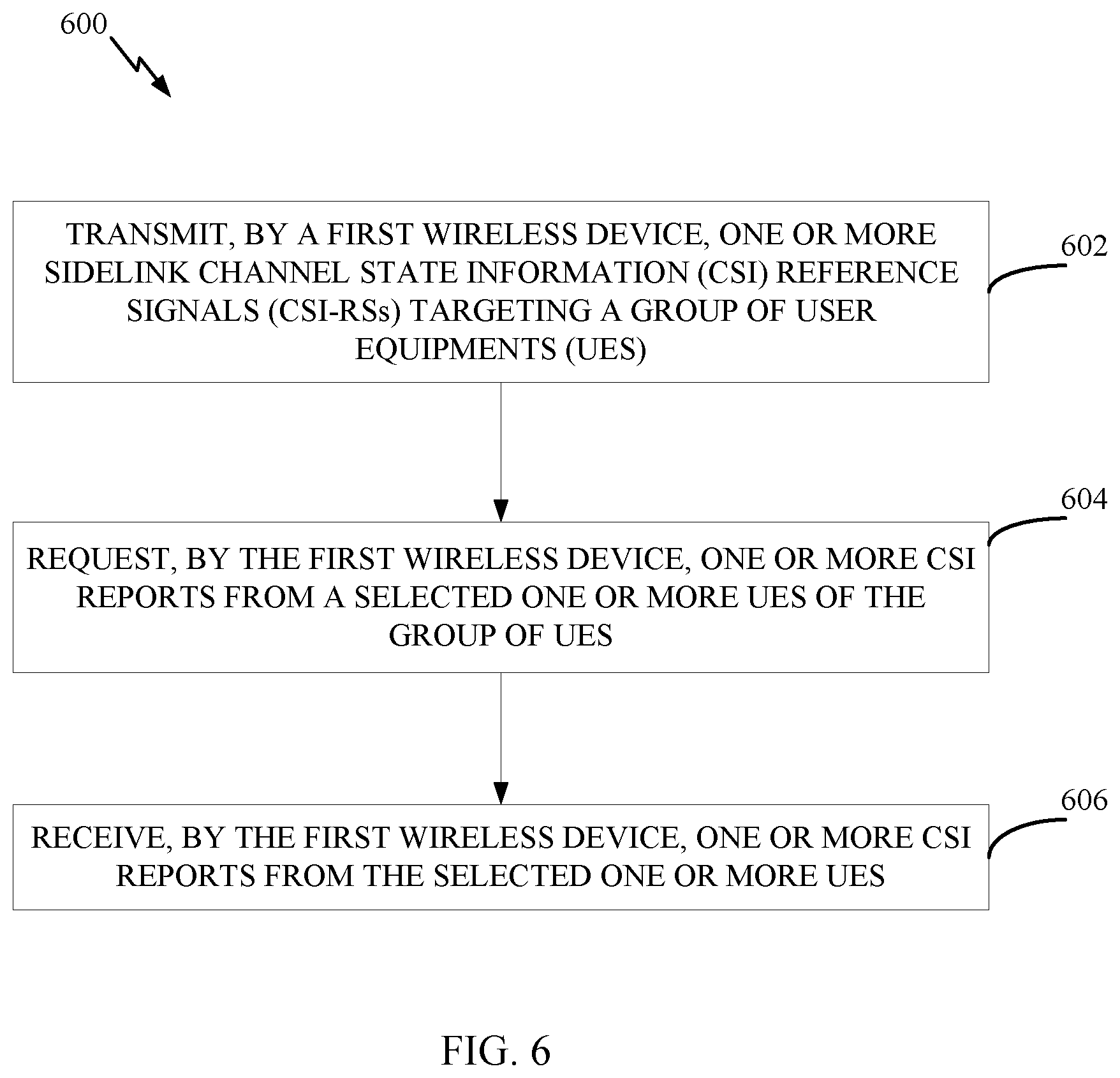
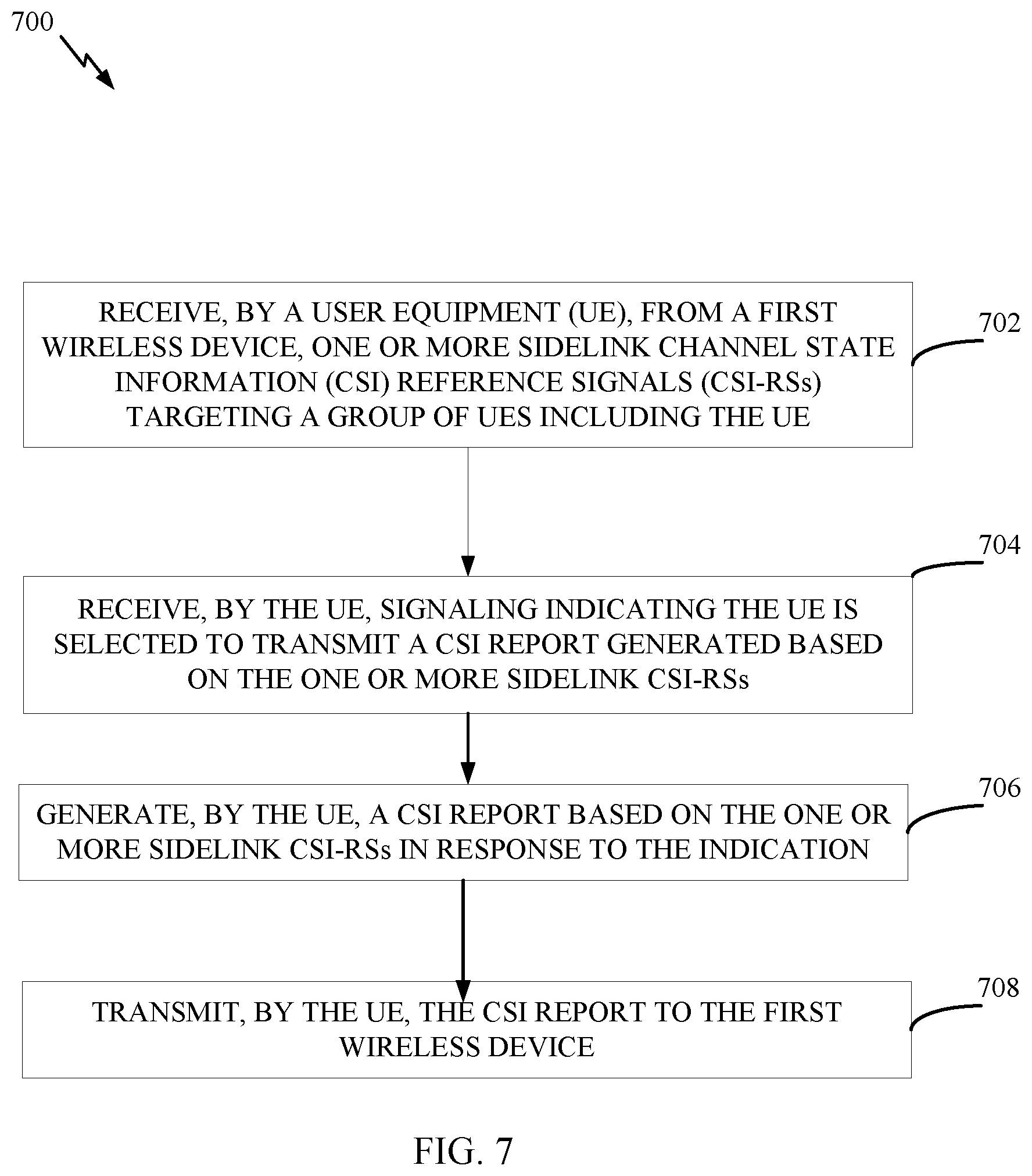
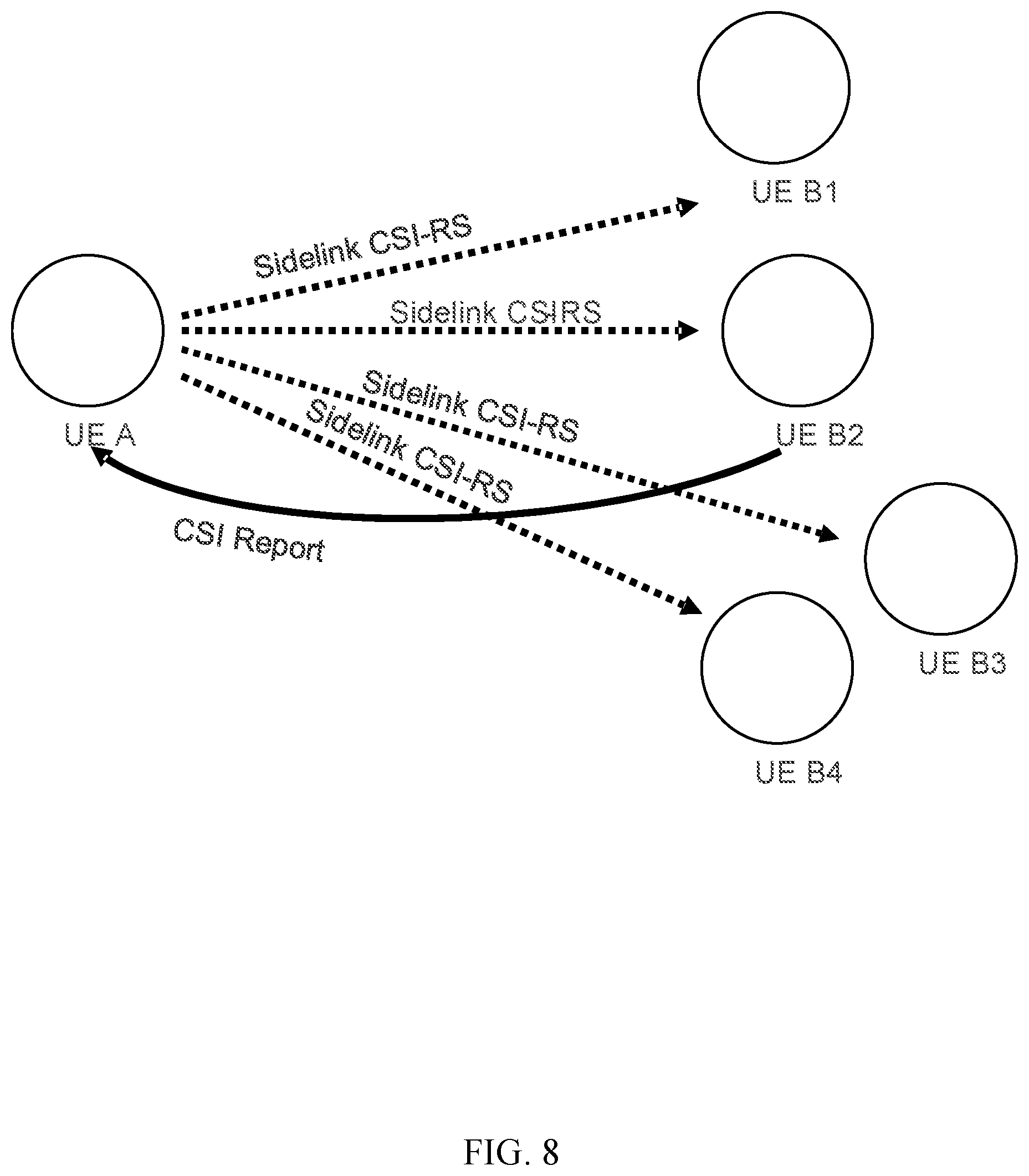
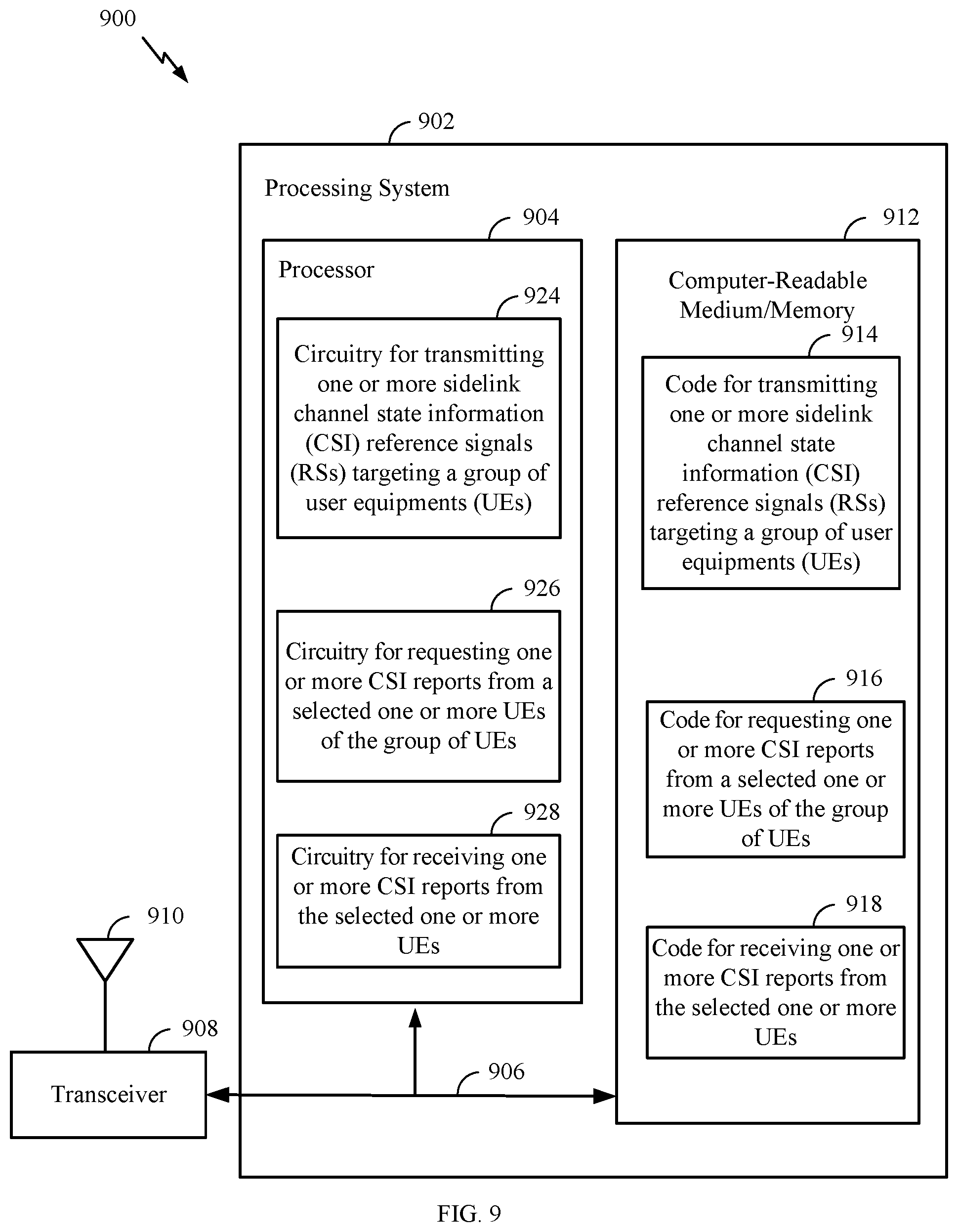
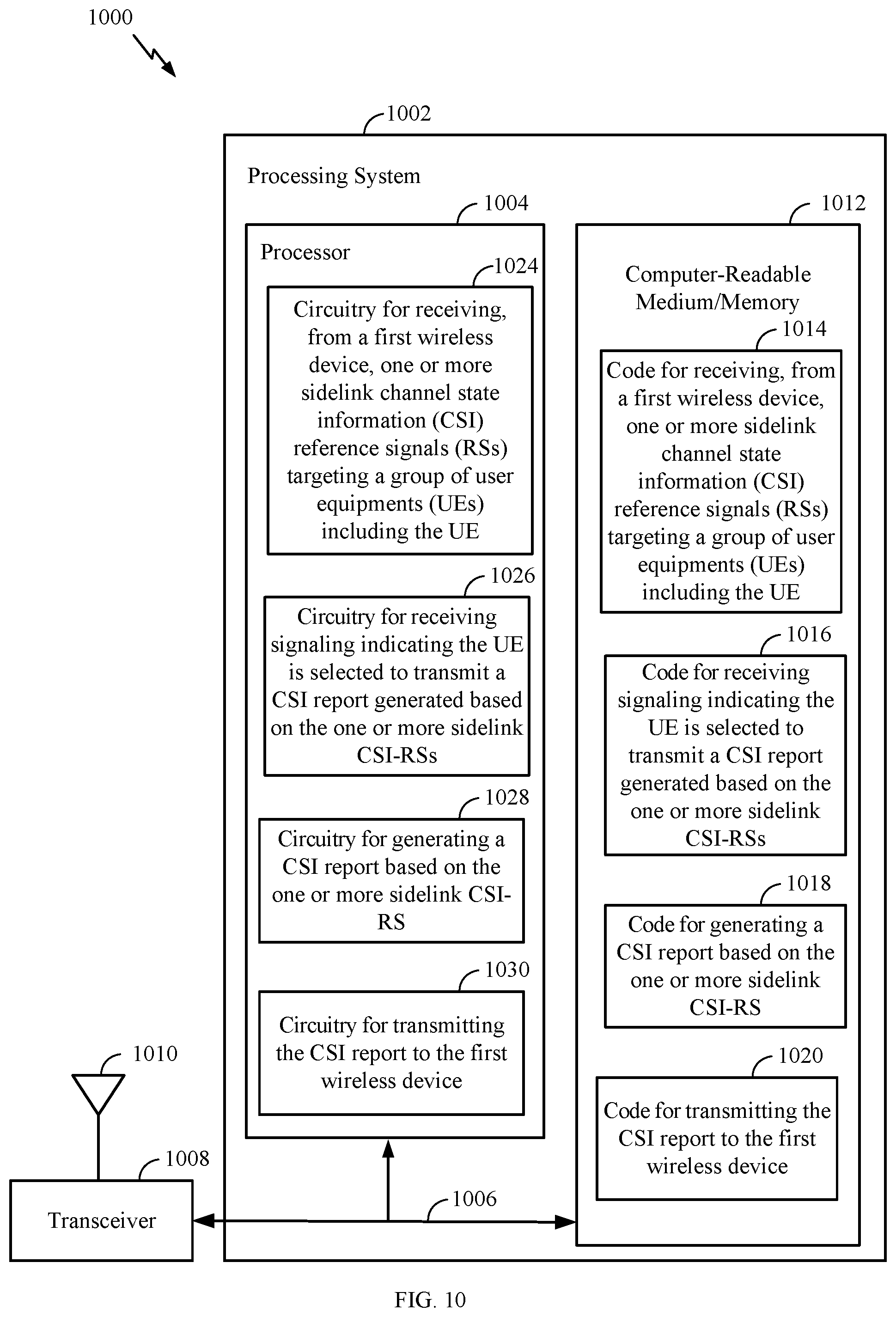
| United States Patent Application | 20210083819 |
| Kind Code | A1 |
| TAHERZADEH BOROUJENI; Mahmoud ; et al. | March 18, 2021 |
GROUPCAST SIDELINK CSI-RS WITH SELECTIVE CSI REPORTS
Abstract
Some aspects provide a method for wireless communication by a first wireless device. The method generally includes transmitting one or more sidelink channel state information (CSI) reference signals (CSI-RSs) targeting a group of user equipments (UEs). The method generally includes requesting one or more CSI reports from a selected one or more UEs of the group of UEs. The method generally includes receiving one or more CSI reports from the selected one or more UEs.
| Inventors: | TAHERZADEH BOROUJENI; Mahmoud; (San Diego, CA) ; MONTOJO; Juan; (San Diego, CA) ; AKKARAKARAN; Sony; (Poway, CA) ; LUO; Tao; (San Diego, CA) ; LI; Junyi; (Chester, NJ) ; RYU; Jung Ho; (Fort Lee, NJ) ; GULATI; Kapil; (Belle Mead, NJ) ; CHENG; Hong; (Basking Ridge, NJ) | ||||||||||
| Applicant: |
|
||||||||||
|---|---|---|---|---|---|---|---|---|---|---|---|
| Family ID: | 1000005066159 | ||||||||||
| Appl. No.: | 17/007349 | ||||||||||
| Filed: | August 31, 2020 |
Related U.S. Patent Documents
| Application Number | Filing Date | Patent Number | ||
|---|---|---|---|---|
| 62899694 | Sep 12, 2019 | |||
| Current U.S. Class: | 1/1 |
| Current CPC Class: | H04L 5/0048 20130101 |
| International Class: | H04L 5/00 20060101 H04L005/00 |
Claims
1. An apparatus for wireless communication by a first wireless device, comprising: at least one processor configured to: transmit one or more sidelink channel state information (CSI) reference signals (CSI-RSs) targeting a group of user equipments (UEs); request one or more CSI reports from a selected one or more UEs of the group of UEs; and receive one or more CSI reports from the selected one or more UEs; and a memory coupled with the at least one processor.
2. The apparatus of claim 1, wherein the at least one processor is configured to request time-staggered CSI reports from a plurality of UEs of the group of UEs.
3. The apparatus of claim 1, wherein the at least one processor is configured to request simultaneous CSI reports from a plurality of UEs of the group of UEs.
4. The apparatus of claim 3, wherein the simultaneous CSI reports are multiplexed via at least one of frequency division multiplexing (FDM) or spatial division multiplexing (SDM).
5. The apparatus of claim 1, wherein the at least one processor is configured to select a plurality of UEs of the group of UEs based on an ability of the first wireless device to receive CSI reports from the plurality of UEs using a same receive beam.
6. The apparatus of claim 1, wherein the at least one processor is configured to indicate the selected one or more UEs via sidelink control information (SCI).
7. The apparatus of claim 1, wherein the at least one processor is configured to select the one or more UEs based on at least one of: a radio resource control (RRC) configuration by a base station or dynamic signaling by the base station.
8. The apparatus of claim 1, wherein the at least one processor is further configured to: receive downlink control information (DCI); and transmit the one or more sidelink CSI-RSs in response to the DCI.
9. The apparatus of claim 8, wherein the DCI comprises a group DCI transmitted to the first wireless device and the group of UEs.
10. The apparatus of claim 8, wherein the DCI indicates the first wireless device is to transmit the sidelink CSI-RS and the UEs selected to transmit CSI reports.
11. The apparatus of claim 1, wherein: a first one or more of the selected UEs are configured to report a first subset of CSI parameters; and a second one or more of the selected UEs are configured to report a second subset of the CSI parameters.
12. The apparatus of claim 11, wherein: the first subset of CSI parameters are associated with coherent CSI information; and the second subset of CSI parameters are associated with non-coherent CSI.
13. An apparatus for wireless communication by a user equipment (UE), the method comprising: at least one processor configured to: receive, from a first wireless device, one or more sidelink channel state information (CSI) reference signals (CSI-RSs) targeting a group of UEs including the UE; receive signaling indicating the UE is selected to transmit a CSI report generated based on the one or more sidelink CSI-RSs; generate a CSI report based on the one or more sidelink CSI-RSs; and transmit the CSI report to the first wireless device; and a memory coupled with the at least one processor.
14. The apparatus of claim 13, wherein the signaling indicates the UE is to transmit the CSI report as one of a set of time-staggered CSI reports from selected UEs of the group of UEs.
15. The apparatus of claim 13, wherein the signaling indicates the UE is to transmit the CSI report simultaneously with CSI reports from at least one other UE of the group of UEs.
16. The apparatus of claim 15, wherein the simultaneous CSI reports are multiplexed via at least one of frequency division multiplexing (FDM) or spatial division multiplexing (SDM).
17. The apparatus of claim 15, wherein the at least one processor is configured to receive the request via sidelink control information (SCI).
18. The apparatus of claim 17, wherein the SCI configures the UE to report a subset of CSI parameters.
19. The apparatus of claim 18, wherein the subset of CSI parameters are associated with coherent CSI information or non-coherent CSI.
20. A method for wireless communication by a first wireless device, the method comprising: transmitting one or more sidelink channel state information (CSI) reference signals (CSI-RSs) targeting a group of user equipments (UEs); requesting one or more CSI reports from a selected one or more UEs of the group of UEs; and receiving one or more CSI reports from the selected one or more UEs.
21. The method of claim 20, wherein requesting the CSI reports comprises at least one of: requesting time-staggered CSI reports from a plurality of UEs of the group of UEs and requesting simultaneous CSI reports from a plurality of UEs of the group of UEs.
22. The method of claim 21, wherein the simultaneous CSI reports are multiplexed via at least one of frequency division multiplexing (FDM) or spatial division multiplexing (SDM).
23. The method of claim 20, wherein selected plurality of UEs of the group of UEs are selected based on an ability of the first wireless device to receive CSI reports from the plurality of UEs using a same receive beam.
24. The method of claim 20, wherein: a first one or more of the selected UEs are configured to report a first subset of CSI parameters associated with coherent CSI information; and a second one or more of the selected UEs are configured to report a second subset of the CSI parameters associated with non-coherent CSI.
25. An method for wireless communication by a user equipment (UE), the method comprising: receiving, from a first wireless device, one or more sidelink channel state information (CSI) reference signals (RS) targeting a group of UEs including a UE; receiving signaling indicating the UE is selected to transmit a CSI report generated based on the one or more sidelink CSI-RSs; generating a CSI report based on the one or more sidelink CSI-RSs; and transmitting the CSI report to the first wireless device.
26. The method of claim 25, wherein the signaling indicates the UE is to transmit the CSI report as one of a set of time-staggered CSI reports from selected UEs of the group of UEs.
27. The method of claim 25, wherein the signaling indicates the UE is to transmit the CSI report simultaneously with CSI reports from at least one other UE of the group of UEs.
28. The method of claim 27, wherein the simultaneous CSI reports are multiplexed via at least one of frequency division multiplexing (FDM) or spatial division multiplexing (SDM).
29. The method of claim 27, wherein the signaling is signaled via sidelink control information (SCI).
30. The method of claim 29, wherein the SCI configures the UE to report a subset of CSI parameters associated with coherent CSI information or non-coherent CSI.
Description
CROSS-REFERENCE TO RELATED APPLICATION(S)
[0001] This application claims benefit of and priority to U.S. Provisional Application No. 62/899,694, filed Sep. 12, 2019, which is hereby assigned to the assignee hereof and hereby expressly incorporated by reference herein in its entirety as if fully set forth below and for all applicable purposes.
TECHNICAL FIELD
[0002] Aspects of the present disclosure relate to wireless communications, and more particularly, to techniques for managing channel state information (CSI) reporting between user equipments (UEs) via a sidelink channel.
BACKGROUND
[0003] Wireless communication systems are widely deployed to provide various telecommunication services such as telephony, video, data, messaging, broadcasts, etc. These wireless communication systems may employ multiple-access technologies capable of supporting communication with multiple users by sharing available system resources (for example, bandwidth, transmit power, etc.). Examples of such multiple-access systems include 3rd Generation Partnership Project (3GPP) Long Term Evolution (LTE) systems, LTE Advanced (LTE-A) systems, code division multiple access (CDMA) systems, time division multiple access (TDMA) systems, frequency division multiple access (FDMA) systems, orthogonal frequency division multiple access (OFDMA) systems, single-carrier frequency division multiple access (SC-FDMA) systems, and time division synchronous code division multiple access (TD-SCDMA) systems, to name a few.
[0004] These multiple access technologies have been adopted in various telecommunication standards to provide a common protocol that enables different wireless devices to communicate on a municipal, national, regional, and even global level. New radio (for example, 5G NR) is an example of an emerging telecommunication standard. NR is a set of enhancements to the LTE mobile standard promulgated by 3GPP. NR is designed to better support mobile broadband Internet access by improving spectral efficiency, lowering costs, improving services, making use of new spectrum, and better integrating with other open standards using OFDMA with a cyclic prefix (CP) on the downlink (DL) and on the uplink (UL). To these ends, NR supports beamforming, multiple-input multiple-output (MIMO) antenna technology, and carrier aggregation.
[0005] However, as the demand for mobile broadband access continues to increase, there exists a need for further improvements in NR and LTE technology. Preferably, these improvements should be applicable to other multi-access technologies and the telecommunication standards that employ these technologies.
SUMMARY
[0006] The systems, methods, and devices of the disclosure each have several innovative aspects, no single one of which is solely responsible for the desirable attributes. Without limiting the scope of this disclosure as expressed by the claims which follow, some features will now be discussed briefly. After considering this discussion, and particularly after reading the section entitled "Detailed Description" one will understand how the features of this disclosure provide advantages that include improved sidelink channel state information (CSI) reporting.
[0007] Aspects of the disclosure can be implemented in a method for wireless communication by a first wireless device. The method generally includes transmitting one or more sidelink CSI reference signals (CSI-RSs) targeting a group of user equipments (UEs). The method generally includes requesting one or more CSI reports from a selected one or more UEs of the group of UEs. The method generally includes receiving one or more CSI reports from the selected one or more UEs.
[0008] Aspects of the disclosure can be implemented in a method for wireless communication by an UE. The method generally includes receiving, from a first wireless device, one or more sidelink CSI-RSs targeting a group of UEs including the UE. The method generally includes receiving signaling indicating the UE is selected to transmit a CSI report generated based on the one or more sidelink CSI-RSs. The method generally includes generating a CSI report based on the one or more sidelink CSI-RSs. The method generally includes transmitting the CSI report to the first wireless device.
[0009] Aspects of the disclosure can be implemented in an apparatus for wireless communication by a first wireless device. The apparatus generally includes at least one processor configured to transmit one or more sidelink CSI-RSs targeting a group of UEs. The at least one processor is configured to request one or more CSI reports from a selected one or more UEs of the group of UEs. The at least one processor is configured to receive one or more CSI reports from the selected one or more UEs. The apparatus generally includes a memory coupled with the at least one processor.
[0010] Aspects of the disclosure can be implemented in an apparatus for wireless communication by an UE. The apparatus generally includes at least one processor configured to receive, from a first wireless device, one or more sidelink CSI-RSs targeting a group of UEs including the UE. The at least one processor is configured to receive signaling indicating the UE is selected to transmit a CSI report generated based on the one or more sidelink CSI-RSs. The at least one processor is configured to generate a CSI report based on the one or more sidelink CSI-RSs. The at least one processor is configured to transmit the CSI report to the first wireless device. The apparatus generally includes a memory coupled with the at least one processor.
[0011] Aspects of the disclosure can be implemented in an apparatus for wireless communication by a first wireless device. The apparatus generally includes means for transmitting one or more sidelink CSI-RSs targeting a group of UEs. The apparatus generally includes means for requesting one or more CSI reports from a selected one or more UEs of the group of UEs. The apparatus generally includes means for receiving one or more CSI reports from the selected one or more UEs.
[0012] Aspects of the disclosure can be implemented in an apparatus for wireless communication by an UE. The apparatus generally includes means for receiving, from a first wireless device, one or more sidelink CSI-RSs targeting a group of UEs including the UE. The apparatus generally includes means for receiving signaling indicating the UE is selected to transmit a CSI report generated based on the one or more sidelink CSI-RSs. The apparatus generally includes means for generating a CSI report based on the one or more sidelink CSI-RSs. The apparatus generally includes means for transmitting the CSI report to the first wireless device.
[0013] Aspects of the disclosure can be implemented in a computer readable medium storing computer executable code thereon for wireless communication. The computer readable medium generally includes code for transmitting one or more sidelink CSI-RSs targeting a group of UEs. The computer readable medium generally includes code for requesting one or more CSI reports from a selected one or more UEs of the group of UEs. The computer readable medium generally includes code for receiving one or more CSI reports from the selected one or more UEs.
[0014] Aspects of the disclosure can be implemented in a computer readable medium storing computer executable code thereon wireless communication. The computer readable medium generally includes code for receiving, from a first wireless device, one or more sidelink CSI-RSs targeting a group of UEs including the UE. The computer readable medium generally includes code for receiving signaling indicating the UE is selected to transmit a CSI report generated based on the one or more sidelink CSI-RSs. The computer readable medium generally includes code for generating a CSI report based on the one or more sidelink CSI-RSs. The computer readable medium generally includes code for transmitting the CSI report to the first wireless device.
[0015] To the accomplishment of the foregoing and related ends, the one or more aspects comprise the features hereinafter fully described and particularly pointed out in the claims. The following description and the appended drawings set forth in detail some illustrative features of the one or more aspects. These features are indicative, however, of but a few of the various ways in which the principles of various aspects may be employed.
BRIEF DESCRIPTION OF THE DRAWINGS
[0016] Details of one or more implementations of the subject matter described in this disclosure are set forth in the accompanying drawings and the description below. However, the accompanying drawings illustrate only some typical aspects of this disclosure and are therefore not to be considered limiting of its scope. Other features, aspects, and advantages will become apparent from the description, the drawings and the claims.
[0017] FIG. 1 shows an example wireless communication network in which some aspects of the present disclosure may be performed.
[0018] FIG. 2 shows a block diagram illustrating an example base station (BS) and an example user equipment (UE) in accordance with some aspects of the present disclosure.
[0019] FIG. 3 is an example frame format for certain wireless communication systems (e.g., new radio (NR)), in accordance with certain aspects of the present disclosure.
[0020] FIG. 4 illustrates an example vehicle-to-everything (V2X) communication system, in accordance with certain aspects of the present disclosure.
[0021] FIG. 5 illustrates another example V2X communication system, in accordance with certain aspects of the present disclosure.
[0022] FIG. 6 is a flow diagram illustrating example operations for wireless communication by a first wireless device in accordance with some aspects of the present disclosure.
[0023] FIG. 7 is a flow diagram illustrating example operations for wireless communication by an apparatus in accordance with some aspects of the present disclosure.
[0024] FIG. 8 is a diagram illustrating example CSI report configuration and reporting for wireless communication in accordance with some aspects of the present disclosure.
[0025] FIG. 9 is a block diagram illustrating an example communications device that may include various components configured to perform operations for the techniques disclosed herein in accordance with aspects of the present disclosure.
[0026] FIG. 10 is a block diagram illustrating an example communications device that may include various components configured to perform operations for the techniques disclosed herein in accordance with aspects of the present disclosure.
[0027] To facilitate understanding, identical reference numerals have been used, where possible, to designate identical elements that are common to the figures. It is contemplated that elements disclosed in one aspect may be beneficially utilized on other aspects without specific recitation.
DETAILED DESCRIPTION
[0028] Aspects of the present disclosure provide apparatus, methods, processing systems, and computer readable mediums for managing channel state information (CSI) reporting via a sidelink channel between sidelink devices, such as between user equipments (UEs). As will be described, the techniques presented herein allow a CSI reference signal (CSI-RS) transmitting UE to select which UEs send CSI reports based on the CSI-RS.
[0029] Allowing a UE transmitting sidelink CSI-RSs to a set of other UEs, such as a groupcast CSI-RS, to select which of the UEs in the set report CSI may help make better use of system resources, adapt sidelink CSI reporting to certain UEs of interest, and/or help stagger CSI reporting from multiple UEs.
[0030] The following description provides examples of groupcast sidelink CSI-RS with selecting CSI reporting, and is not limiting of the scope, applicability, or examples set forth in the claims. Changes may be made in the function and arrangement of elements discussed without departing from the scope of the disclosure. Various examples may omit, substitute, or add various procedures or components as appropriate. For instance, the methods described may be performed in an order different from that described, and various steps may be added, omitted, or combined. Also, features described with respect to some examples may be combined in some other examples. For example, an apparatus may be implemented or a method may be practiced using any number of the aspects set forth herein. In addition, the scope of the disclosure is intended to cover such an apparatus or method which is practiced using other structure, functionality, or structure and functionality in addition to, or other than, the various aspects of the disclosure set forth herein. It should be understood that any aspect of the disclosure disclosed herein may be embodied by one or more elements of a claim.
[0031] In general, any number of wireless networks may be deployed in a given geographic area. Each wireless network may support a particular radio access technology (RAT) and may operate on one or more frequencies. A RAT may also be referred to as a radio technology, an air interface, etc. A frequency may also be referred to as a carrier, a subcarrier, a frequency channel, a tone, a subband, etc. Each frequency may support a single RAT in a given geographic area in order to avoid interference between wireless networks of different RATs. In some cases, a 5G NR RAT network may be deployed.
[0032] The techniques described herein may be used for various wireless networks and radio technologies. While aspects may be described herein using terminology commonly associated with 3G, 4G, and/or new radio (e.g., 5G NR) wireless technologies, aspects of the present disclosure can be applied in other generation-based communication systems.
[0033] NR access (for example, 5G NR) may support various wireless communication services, such as enhanced mobile broadband (eMBB) targeting wide bandwidth, millimeter wave (mmWave) targeting high carrier frequency, massive machine type communications MTC (mMTC) targeting non-backward compatible MTC techniques, or mission critical services targeting ultra-reliable low-latency communications (URLLC). These services may include latency and reliability requirements. These services may also have different transmission time intervals (TTI) to meet respective quality of service (QoS) requirements. In addition, these services may co-exist in the same time-domain resource (for example, a slot or subframe) or frequency-domain resource (for example, component carrier).
[0034] FIG. 1 illustrates an example wireless communication network 100 in which aspects of the present disclosure may be performed. For example, as shown in FIG. 1, UE 120a and/or UE 120b may include a Sidelink CSI Report Module (122a, 122b), that may be configured to perform operations to manage sidelink CSI reporting as described herein.
[0035] As shown in FIG. 1, the wireless communication network 100 may be in communication with a core network 132. The core network 132 may in communication with one or more base station (BSs) 110110a-z (each also individually referred to herein as BS 110 or collectively as BSs 110) and/or user equipment (UE) 120a-y (each also individually referred to herein as UE 120 or collectively as UEs 120) in the wireless communication network 100 via one or more interfaces.
[0036] A BS 110 may provide communication coverage for a particular geographic area, sometimes referred to as a "cell", which may be stationary or may move according to the location of a mobile BS 110. In some examples, the BSs 110 may be interconnected to one another or to one or more other BSs or network nodes (not shown) in wireless communication network 100 through various types of backhaul interfaces (for example, a direct physical connection, a wireless connection, a virtual network, or the like) using any suitable transport network. In the example shown in FIG. 1, the BSs 110a, 110b and 110c may be macro BSs for the macro cells 102a, 102b and 102c, respectively. The BS 110x may be a pico BS for a pico cell 102x. The BSs 110y and 110z may be femto BSs for the femto cells 102y and 102z, respectively. ABS may support one or multiple cells.
[0037] The BSs 110 communicate with UEs 120 in the wireless communication network 100. The UEs 120 may be dispersed throughout the wireless communication network 100, and each UE 120 may be stationary or mobile.
[0038] Wireless communication network 100 may also include relay stations (for example, relay station 110r), also referred to as relays or the like, that receive a transmission of data or other information from an upstream station (for example, a BS 110a or a UE 120r) and sends a transmission of the data or other information to a downstream station (for example, a UE 120 or a BS 110), or that relays transmissions between UEs 120, to facilitate communication between devices.
[0039] A network controller 130 may couple to a set of BSs 110 and provide coordination and control for these BSs 110. The network controller 130 may communicate with the BSs 110 via a backhaul. In aspects, the network controller 130 may be in communication with a core network 132 (e.g., a 5G Core Network (5GC)), which provides various network functions such as Access and Mobility Management, Session Management, User Plane Function, Policy Control Function, Authentication Server Function, Unified Data Management, Application Function, Network Exposure Function, Network Repository Function, Network Slice Selection Function, etc.
[0040] FIG. 2 illustrates example components of BS 110a and UE 120a (e.g., the wireless communication network 100 of FIG. 1), which may be used to implement aspects of the present disclosure.
[0041] At the BS 110a, a transmit processor 220 may receive data from a data source 212 and control information from a controller/processor 240. The control information may be for the physical broadcast channel (PBCH), physical control format indicator channel (PCFICH), physical hybrid ARQ indicator channel (PHICH), physical downlink control channel (PDCCH), group common PDCCH (GC PDCCH), etc. The data may be for the physical downlink shared channel (PDSCH), etc. The processor 220 may process (for example, encode and symbol map) the data and control information to obtain data symbols and control symbols, respectively. The transmit processor 220 may also generate reference symbols, such as for the primary synchronization signal (PSS), secondary synchronization signal (SSS), and channel state information reference signal (CSI-RS). A transmit (TX) multiple-input multiple-output (MIMO) processor 230 may perform spatial processing (for example, precoding) on the data symbols, the control symbols, or the reference symbols, if applicable, and may provide output symbol streams to the modulators (MODs) in transceivers 232a-232t. Each modulator may process a respective output symbol stream (for example, for OFDM, etc.) to obtain an output sample stream. Each modulator may further process (for example, convert to analog, amplify, filter, and upconvert) the output sample stream to obtain a downlink signal. Downlink signals from the modulators in transceivers 232a-232t may be transmitted via the antennas 234a-234t, respectively.
[0042] At the UE 120a, the antennas 252a-252r may receive the downlink signals from the BS 110a (or sidelink signals from a sidelink device, such as UE 120b) and may provide received signals to the demodulators (DEMODs) in transceivers 254a-254r, respectively. Each demodulator may condition (for example, filter, amplify, downconvert, and digitize) a respective received signal to obtain input samples. Each demodulator may further process the input samples (for example, for OFDM, etc.) to obtain received symbols. A MIMO detector 256 may obtain received symbols from all the demodulators in transceivers 254a-254r, perform MIMO detection on the received symbols if applicable, and provide detected symbols. A receive processor 258 may process (for example, demodulate, deinterleave, and decode) the detected symbols, provide decoded data for the UE 120a to a data sink 260, and provide decoded control information to a controller/processor 280.
[0043] On the uplink or sidelink, at UE 120a, a transmit processor 264 may receive and process data (for example, for the physical uplink shared channel (PUSCH) or the physical sidelink shared channel (PSSCH)) from a data source 262 and control information (for example, for the physical uplink control channel (PUCCH) or physical sidelink control channel (PSCCH)) from the controller/processor 280. The transmit processor 264 may also generate reference symbols for a reference signal (for example, for the sounding reference signal (SRS) or CSI-RS. The symbols from the transmit processor 264 may be precoded by a TX MIMO processor 266 if applicable, further processed by the modulators in transceivers 254a-254r (for example, for SC-FDM, etc.), and transmitted to the BS 110a or sidelink UE 120b. At the BS 110a (or at a receiving sidelink UE), the uplink signals from the UE 120a may be received by the antennas 234, processed by the demodulators 232, detected by a MIMO detector 236 if applicable, and further processed by a receive processor 238 to obtain decoded data and control information sent by the UE 120a. The receive processor 238 may provide the decoded data to a data sink 239 and the decoded control information to the controller/processor 240.
[0044] The memories 242 and 282 may store data and program codes for BS 110 and UE 120, respectively. A scheduler 244 may schedule UEs for data transmission on the downlink or uplink.
[0045] Antennas 252, processors 266, 258, 264, and/or controller/processor 280 of the UE 120a and/or antennas 234, processors 220, 230, 238, and/or controller/processor 240 of the BS 110a may be used to perform the various techniques and methods described herein. As shown in FIG. 2, the controller/processor 280 of the UE 120a has a Sidelink CSI Report Module 122 that may be configured to configure/schedule UE 120s own CSI report and/or process a sidelink CSI report from another UE. Although shown at the Controller/Processor, other components of the UE may be used to perform the operations described herein.
[0046] NR may utilize orthogonal frequency division multiplexing (OFDM) with a cyclic prefix (CP) on the uplink and downlink. NR may support half-duplex operation using time division duplexing (TDD). OFDM and single-carrier frequency division multiplexing (SC-FDM) partition the system bandwidth into multiple orthogonal subcarriers, which are also commonly referred to as tones, bins, etc. Each subcarrier may be modulated with data. Modulation symbols may be sent in the frequency domain with OFDM and in the time domain with SC-FDM. The spacing between adjacent subcarriers may be fixed, and the total number of subcarriers may be dependent on the system bandwidth. The minimum resource allocation, called a resource block (RB), may be 12 consecutive subcarriers. The system bandwidth may also be partitioned into subbands. For example, a subband may cover multiple RBs. NR may support a base subcarrier spacing (SCS) of 15 KHz and other SCS may be defined with respect to the base SCS (e.g., 30 kHz, 60 kHz, 120 kHz, 240 kHz, etc.).
[0047] FIG. 3 is a diagram showing an example of a frame format 300 for NR. The transmission timeline for each of the downlink and uplink may be partitioned into units of radio frames. Each radio frame may have a predetermined duration (e.g., 10 ms) and may be partitioned into 10 subframes, each of 1 ms, with indices of 0 through 9. Each subframe may include a variable number of slots (e.g., 1, 2, 4, 8, 16, . . . slots) depending on the SCS. Each slot may include a variable number of symbol periods (e.g., 7, 12, or 14 symbols) depending on the SCS. The symbol periods in each slot may be assigned indices. A sub-slot structure refers to a transmit time interval having a duration less than a slot (e.g., 2, 3, or 4 symbols). Each symbol in a slot may indicate a link direction (e.g., DL, UL, or flexible) for data transmission and the link direction for each subframe may be dynamically switched. The link directions may be based on the slot format. Each slot may include DL/UL data as well as DL/UL control information.
[0048] In some circumstances, two or more subordinate entities (for example, UEs) may communicate with each other using sidelink signals. As described above, vehicle-to-vehicle (V2V) and vehicle-to-everything (V2X) communications are examples of communications that may be transmitted via a sidelink. Other applications of sidelink communications may include public safety or service announcement communications, communications for proximity services, communications for UE-to-network relaying, device-to-device (D2D) communications, Internet of Everything (IoE) communications, Internet of Things (IoT) communications, mission-critical mesh communications, among other suitable applications. Generally, a sidelink may refer to a direct link between one subordinate entity (for example, UE1) and another subordinate entity (for example, UE2). As such, a sidelink may be used to transmit and receive a communication (also referred to herein as a "sidelink signal") without relaying the communication through a scheduling entity (for example, a BS), even though the scheduling entity may be utilized for scheduling or control purposes. In some examples, a sidelink signal may be communicated using a licensed spectrum (unlike wireless local area networks, which typically use an unlicensed spectrum).
[0049] Various sidelink channels may be used for sidelink communications, including a physical sidelink discovery channel (PSDCH), a physical sidelink control channel (PSCCH), a physical sidelink shared channel (PSSCH), and a physical sidelink feedback channel (PSFCH). The PSDCH may carry discovery expressions that enable proximal devices to discover each other. The PSCCH may carry control signaling such as sidelink resource configurations and other parameters used for data transmissions, and the PSSCH may carry the data transmissions. The PSFCH may carry feedback such as channel state information (CSI) related to a sidelink channel quality.
[0050] FIGS. 4 and 5 show diagrammatic representations of example vehicle to everything (V2X) systems in accordance with some aspects of the present disclosure. For example, the vehicles shown in FIG. 4 and FIG. 5 may communicate via sidelink channels and may perform sidelink CSI reporting as described herein.
[0051] The V2X systems, provided in FIG. 4 and FIG. 5 provide two complementary transmission modes. A first transmission mode, shown by way of example in FIG. 4, involves direct communications (for example, also referred to as side link communications) between participants in proximity to one another in a local area. A second transmission mode, shown by way of example in FIG. 5, involves network communications through a network, which may be implemented over a Uu interface (for example, a wireless communication interface between a radio access network (RAN) and a UE).
[0052] Referring to FIG. 4, a V2X system 400 (for example, including vehicle to vehicle (V2V) communications) is illustrated with two vehicles 402, 404. The first transmission mode allows for direct communication between different participants in a given geographic location. As illustrated, a vehicle can have a wireless communication link 406 with an individual (vehicle-to-person (V2P)) (for example, via a UE) through a PC5 interface. Communications between the vehicles 402 and 404 may also occur through a PC5 interface 408. In a like manner, communication may occur from a vehicle 402 to other highway components (for example, highway component 410), such as a traffic signal or sign (V2I) through a PC5 interface 312. With respect to each communication link illustrated in FIG. 4, two-way communication may take place between elements, therefore each element may be a transmitter and a receiver of information. The V2X system 400 may be a self-managed system implemented without assistance from a network entity. A self-managed system may enable improved spectral efficiency, reduced cost, and increased reliability as network service interruptions do not occur during handover operations for moving vehicles. The V2X system may be configured to operate in a licensed or unlicensed spectrum, thus any vehicle with an equipped system may access a common frequency and share information. Such harmonized/common spectrum operations allow for safe and reliable operation.
[0053] FIG. 5 shows a V2X system 500 for communication between a vehicle 552 and a vehicle 554 through a network entity 556. These network communications may occur through discrete nodes, such as a base station (for example, an eNB or gNB), that sends and receives information to and from (for example, relays information between) vehicles 552, 554. The network communications through vehicle to network (V2N) links 558 and 510 may be used, for example, for long range communications between vehicles, such as for communicating the presence of a car accident a distance ahead along a road or highway. Other types of communications may be sent by the node to vehicles, such as traffic flow conditions, road hazard warnings, environmental/weather reports, and service station availability, among other examples. Such data can be obtained from cloud-based sharing services.
[0054] As mentioned above, aspects of the present disclosure relate to managing sidelink CSI reporting. CSI in new radio (NR) includes a variety of channel quality metrics. For example, channel quality metrics may include Channel Quality Indicator (CQI); Precoding Matrix Indicator (PMI), CSI-RS Resource Indicator (CRI), Strongest Layer Indication (SLI), Rank Indication (RI), and L1 reference signal receive power (L1-RSRP) (for beam management).
[0055] For vehicle-to-everything (V2X) deployments, such as described with reference to FIGS. 4 and 5, CSI reporting can be enabled and disabled by configuration. For flexibility, devices may be configured to report a subset of the metrics for CSI reporting.
[0056] CSI reporting configuration and scheduling in NR may depend on the type of CSI reporting. The type of channel that carries the CSI report may depend on the type of CSI reporting. For example, periodic CSI reporting may be carried on a short physical uplink control channel (PUCCH) or a long PUCCH, while semi-persistent (SP) CSI reporting may be carried on a long PUCCH or on a physical uplink shared channel (PUSCH). Resources and transmission parameters (such as modulation and coding scheme (MCS)) for SP-CSI on PUSCH may be allocated semi-persistently using downlink control channel (DCI). SP-CSI may support Type II CSI reporting with minimum periodicity of 5 ms. In some cases, SP-CSI reporting may not be supported for aperiodic CSI-RS (although lack of support does not preclude one CSI report carried by multiple uplink (UL) reporting instances). In NR, aperiodic CSI reporting may be carried on PUSCH multiplexed with or without uplink data. Periodic and semi-persistent (P/SP) reporting in NR may support the following periodicities {5, 10, 20, 40, 80, 160, 320} slots.
[0057] Sidelink CSI-RSs may support CQI and/or RI measurement for no more than two ports. Sidelink CSI-RSs may be confined within the physical sidelink shared channel (PSSCH) transmission. However, more detailed CSI reporting may be desirable for beam management and/or multiple input multiple output (MIMO). These various use cases of sidelink may involve different CSI reporting procedures (e.g., depending on the amount of feedback and the available resources). There are differences between sidelink and conventional (Uu/access link) CSI reporting. For example, CSI reporting is asymmetric on the Uu interface, where a gNB (in NR) schedules all CSI-RSs and CSI reporting. In sidelink CSI reporting, however, the relation between transmitter and receiver may be more symmetric (e.g., from one UE to another UE).
[0058] Thus, techniques for sidelink CSI reporting is desirable.
Example Groupcast Sidelink CSI-RS with Selective CSI Reports
[0059] Aspects of the present disclosure provide for groupcast sidelink channel state information reference signals (CSI-RSs) with selective CSI reporting. According to certain aspects, a sidelink user equipment (UE) may groupcast a CSI-RS to multiple UEs. The UEs may be selectively configured to report CSI. For example, the CSI-RS transmitting UE and/or a base station (BS) can select (e.g., and configured/indicate/request) the UEs (e.g., a subset of UEs) that provide a CSI report for the groupcast CSI-RS.
[0060] FIG. 6 is a flow diagram illustrating example operations 600 for wireless communication, in accordance with certain aspects of the present disclosure. The operations 600 may be performed, for example, by a first sidelink device, such as a UE (e.g., by a UE 120a of FIG. 1 to transmit sidelink CSI-RSs to a group of UEs and receive one or more CSI reports). The operations 600 may be implemented as software components that are executed and run on one or more processors (e.g., controller/processor 280 of FIG. 2). Further, the transmission and reception of signals by the UE in operations 600 may be enabled, for example, by one or more antennas (e.g., antennas 252 of FIG. 2). In certain aspects, the transmission and/or reception of signals by the UE may be implemented via a bus interface of one or more processors (e.g., controller/processor 280) obtaining and/or outputting signals.
[0061] Operations 600 begin, at 602, by transmitting one or more sidelink CSI-RSs targeting a group of UEs. As used herein, the term targeting generally means the UEs are intended recipients of the CSI-RSs. In general, the resources and parameters for groupcast CSI-RSs may be configured by a base station (e.g., the 5G new radio (NR) gNodeB (gNB)), sidelink radio resource control (RRC), scheduled by sidelink control information (SCI) from the CSI-transmitting UE, or scheduled by downlink control information (DCI) from the BS. At 604, the UE requests one or more CSI reports from a selected one or more UEs of the group of UEs. At 606, the UE receives one or more CSI reports from the selected one or more UEs.
[0062] FIG. 7 is a flow diagram illustrating example operations 700 for wireless communication, in accordance with certain aspects of the present disclosure. The operations 700 may be performed, for example, by a UE (e.g., by a UE 120b of FIG. 1 to process a sidelink CSI report configured/scheduled by a UE 120a). The operations 700 may be implemented as software components that are executed and run on one or more processors (e.g., controller/processor 280 of FIG. 2). Further, the transmission and reception of signals by the UE in operations 700 may be enabled, for example, by one or more antennas (e.g., antennas 252 of FIG. 2). In certain aspects, the transmission and/or reception of signals by the UE may be implemented via a bus interface of one or more processors (e.g., controller/processor 280) obtaining and/or outputting signals.
[0063] Operations 700 begin, at 702, by receiving, from a first wireless device, one or more sidelink CSI-RSs targeting a group of UEs including the UE. At 704, the UE receives signaling indicating the UE is selected to transmit a CSI report generated based on the one or more sidelink CSI-RSs. At 706, the UE generates a CSI report based on the one or more sidelink CSI-RSs. At 708, the UE transmits the CSI report to the first wireless device.
[0064] Operations 600 and 700 of FIGS. 6 and 7 may be understood with reference to the diagram of FIG. 8. As shown in FIG. 8, a UE A that groupcasts sidelink CSI-RS to a group of other UEs (UE B1, UE B2, UE B3, and UE B4). As illustrated, only the UE B2 transmits a CSI report based on the groupcast sidelink CSI-RS (while UE B1, UE B2, and UE B3 do not). The selection of UE B2 may be based on a CSI report setting. For example, the CSI report setting may be send through SCI (e.g., from UE A), a configuration by a gNB (not shown), or through dynamic signaling by the gNB (e.g., DCI). Although only one UE (UE B2) is selected in the example shown in FIG. 8, in aspects, multiple of the UEs may be selected (e.g., indicated, configured, and/or requested) to reports CSI.
[0065] In some examples, the CSI-RS transmitting UE may control how the selected UEs transmit their CSI reports. For example, the CSI-RS transmitting UE may request time-staggered CSI reports or simultaneous CSI reports in order to receive all CSI reports. Simultaneous CSI reports may be requested to be multiplexed. These simultaneous CSI reports may be multiplexed via frequency division multiplexing (FDM), spatial division multiplexing (SDM), or both FDM and SDM.
[0066] In some examples, a UE may poll for CSI reports. For example, if CSI reports from a subset of the group of CSI-RS receiving UEs can be received using the same receive (Rx) beam, then those CSI-RS receiving UEs may be polled (e.g., by SCI from the CSI-RS transmitting UE) or may be configured (e.g., by sidelink RRC from CSI-RS transmitting UE) to transmit simultaneous reports (e.g., using FDM, SDM, or both FDM and SDM).
[0067] In some examples, the CSI-RS transmitting UE may request a CSI report from only one of the UEs (as in the example of FIG. 8) in the group or only a subset of them. In some examples, the selection (of which UEs) may be made by CSI report setting through SCI.
[0068] In some examples, the selection (of which UEs are to report CSI) may be based on a configuration by a gNB or through dynamic signaling by the gNB (e.g., through DCI). The DCI triggering the CSI report may be also sent to the CSI-RS transmitting UE to receive the CSI report (as a group DCI or a separate UE-specific DCI).
[0069] In some examples, a group DCI transmitted to the CSI-RS transmitting UE and all the group of CSI-RS-receiving UEs may trigger the CSI report. The group DCI may also indicate the CSI-transmitting UE and/or the subset of UEs.
[0070] The content of the CSI reports may also be configured. For example, a first subset of CSI parameters may be reported by all UEs through time-staggered CSI reports, while a second subset of CSI parameters may be reported by only one UE or only a subset of UEs in the group. The distinction between these two subsets of CSI parameters may be based on whether they correspond to coherent CSI information (e.g., beam, Precoding Matrix Indicator (PMI)) or non-coherent CSI information (e.g., Channel Quality Indicator (CQI)).
[0071] Aspects of the present disclosure provide a mechanism that allows a sidelink CSI-RS transmitting UE to select which UEs (of a group of UEs) are to report CSI based on the transmitted CSI-RS.
[0072] FIG. 9 illustrates a communications device 900 that may include various components (e.g., corresponding to means-plus-function components) configured to perform operations for the techniques disclosed herein, such as the operations illustrated in FIG. 6. The communications device 900 includes a processing system 902 coupled to a transceiver 908 (e.g., a transmitter and/or a receiver). The transceiver 908 is configured to transmit and receive signals for the communications device 900 via an antenna 910, such as the various signals as described herein. The processing system 902 may be configured to perform processing functions for the communications device 900, including processing signals received and/or to be transmitted by the communications device 900.
[0073] The processing system 902 includes a processor 904 coupled to a computer-readable medium/memory 912 via a bus 906. In certain aspects, the computer-readable medium/memory 912 is configured to store instructions (e.g., computer-executable code) that when executed by the processor 904, cause the processor 904 to perform the operations illustrated in FIG. 6, or other operations for performing the various techniques discussed herein for managing CSI reporting between UEs via a sidelink channel. In certain aspects, computer-readable medium/memory 912 stores code 914 for transmitting one or more sidelink CSI-RSs targeting a group of UEs; code 916 for requesting one or more CSI reports from a selected one or more UEs of the group of UEs; and code 918 for receiving one or more CSI reports from the selected one or more UEs. In certain aspects, the processor 904 has circuitry configured to implement the code stored in the computer-readable medium/memory 912. The processor 904 includes circuitry 924 for transmitting one or more sidelink CSI-RSs targeting a group of UEs; circuitry 926 for requesting one or more CSI reports from a selected one or more UEs of the group of UEs; and circuitry 928 for receiving one or more CSI reports from the selected one or more UEs.
[0074] FIG. 10 illustrates a communications device 1000 that may include various components (e.g., corresponding to means-plus-function components) configured to perform operations for the techniques disclosed herein, such as the operations illustrated in FIG. 7. The communications device 1000 includes a processing system 1002 coupled to a transceiver 1008 (e.g., a transmitter and/or a receiver). The transceiver 1008 is configured to transmit and receive signals for the communications device 1000 via an antenna 1010, such as the various signals as described herein. The processing system 1002 may be configured to perform processing functions for the communications device 1000, including processing signals received and/or to be transmitted by the communications device 1000.
[0075] The processing system 1002 includes a processor 1004 coupled to a computer-readable medium/memory 1012 via a bus 1006. In certain aspects, the computer-readable medium/memory 1012 is configured to store instructions (e.g., computer-executable code) that when executed by the processor 1004, cause the processor 1004 to perform the operations illustrated in FIG. 7, or other operations for performing the various techniques discussed herein for managing CSI reporting between UEs via a sidelink channel. In certain aspects, computer-readable medium/memory 1012 stores code 1014 for receiving, from a first wireless device, one or more sidelink CSI-RSs targeting a group of UEs including the UE; code 1016 for receiving signaling indicating the UE is selected to transmit a CSI report generated based on the one or more sidelink CSI-RSs; code 1018 for generating a CSI report based on the one or more sidelink CSI-RS;s and code 1020 for transmitting the CSI report to the first wireless device. In certain aspects, the processor 1004 has circuitry configured to implement the code stored in the computer-readable medium/memory 1012. The processor 1004 includes circuitry 1024 for receiving, from a first wireless device, one or more sidelink CSI-RSs targeting a group of UEs including the UE; circuitry 1026 for receiving signaling indicating the UE is selected to transmit a CSI report generated based on the one or more sidelink CSI-RSs; circuitry 1028 for generating a CSI report based on the one or more sidelink CSI-RSs; and circuitry 1030 for transmitting the CSI report to the first wireless device.
[0076] The techniques described herein may be used for various wireless communication technologies, such as NR (for example, 5G NR), 3GPP Long Term Evolution (LTE), LTE-Advanced (LTE-A), code division multiple access (CDMA), time division multiple access (TDMA), frequency division multiple access (FDMA), orthogonal frequency division multiple access (OFDMA), single-carrier frequency division multiple access (SC-FDMA), time division synchronous code division multiple access (TD-SCDMA), and other networks. The terms "network" and "system" are often used interchangeably. A CDMA network may implement a radio technology such as Universal Terrestrial Radio Access (UTRA), cdma2000, etc. UTRA includes Wideband CDMA (WCDMA) and other variants of CDMA. cdma2000 covers IS-2000, IS-95 and IS-856 standards. A TDMA network may implement a radio technology such as Global System for Mobile Communications (GSM). An OFDMA network may implement a radio technology such as NR (e.g. 5G RA), Evolved UTRA (E-UTRA), Ultra Mobile Broadband (UMB), IEEE 802.11 (Wi-Fi), IEEE 802.16 (WiMAX), IEEE 802.20, Flash-OFDMA, etc. UTRA and E-UTRA are part of Universal Mobile Telecommunication System (UMTS). LTE and LTE-A are releases of UMTS that use E-UTRA. UTRA, E-UTRA, UMTS, LTE, LTE-A and GSM are described in documents from an organization named "3rd Generation Partnership Project" (3GPP). cdma2000 and UMB are described in documents from an organization named "3rd Generation Partnership Project 2" (3GPP2). NR is an emerging wireless communications technology under development.
[0077] In 3GPP, the term "cell" can refer to a coverage area of a Node B (NB) or a NB subsystem serving this coverage area, depending on the context in which the term is used. In NR systems, the term "cell" and BS, next generation NodeB (gNB or gNodeB), access point (AP), distributed unit (DU), carrier, or transmission reception point (TRP) may be used interchangeably. A BS may provide communication coverage for a macro cell, a pico cell, a femto cell, or other types of cells. A macro cell may cover a relatively large geographic area (for example, several kilometers in radius) and may allow unrestricted access by UEs with service subscription. A pico cell may cover a relatively small geographic area and may allow unrestricted access by UEs with service subscription. A femto cell may cover a relatively small geographic area (for example, a home) and may allow restricted access by UEs having an association with the femto cell (for example, UEs in a Closed Subscriber Group (CSG), UEs for users in the home, etc.). A BS for a macro cell may be referred to as a macro BS. A BS for a pico cell may be referred to as a pico BS. ABS for a femto cell may be referred to as a femto BS or a home BS.
[0078] A UE may also be referred to as a mobile station, a terminal, an access terminal, a subscriber unit, a station, a Customer Premises Equipment (CPE), a cellular phone, a smart phone, a personal digital assistant (PDA), a wireless modem, a wireless communication device, a handheld device, a laptop computer, a cordless phone, a wireless local loop (WLL) station, a tablet computer, a camera, a gaming device, a netbook, a smartbook, an ultrabook, an appliance, a medical device or medical equipment, a biometric sensor/device, a wearable device such as a smart watch, smart clothing, smart glasses, a smart wrist band, smart jewelry (for example, a smart ring, a smart bracelet, etc.), an entertainment device (for example, a music device, a video device, a satellite radio, etc.), a vehicular component or sensor, a smart meter/sensor, industrial manufacturing equipment, a global positioning system device, or any other suitable device that is configured to communicate via a wireless or wired medium. Some UEs may be considered machine-type communication (MTC) devices or evolved MTC (eMTC) devices. MTC and eMTC UEs include, for example, robots, drones, remote devices, sensors, meters, monitors, location tags, etc., that may communicate with a BS, another device (for example, remote device), or some other entity. A wireless node may provide, for example, connectivity for or to a network (for example, a wide area network such as Internet or a cellular network) via a wired or wireless communication link. Some UEs may be considered Internet-of-Things (IoT) devices, which may be narrowband IoT (NB-IoT) devices.
[0079] In some examples, access to the air interface may be scheduled. A scheduling entity (for example, a BS) allocates resources for communication among some or all devices and equipment within its service area or cell. The scheduling entity may be responsible for scheduling, assigning, reconfiguring, and releasing resources for one or more subordinate entities. That is, for scheduled communication, subordinate entities utilize resources allocated by the scheduling entity. Base stations are not the only entities that may function as a scheduling entity. In some examples, a UE may function as a scheduling entity and may schedule resources for one or more subordinate entities (for example, one or more other UEs), and the other UEs may utilize the resources scheduled by the UE for wireless communication. In some examples, a UE may function as a scheduling entity in a peer-to-peer (P2P) network, or in a mesh network. In a mesh network example, UEs may communicate directly with one another in addition to communicating with a scheduling entity.
[0080] The methods disclosed herein comprise one or more steps or actions for achieving the methods. The method steps and/or actions may be interchanged with one another without departing from the scope of the claims. In other words, unless a specific order of steps or actions is specified, the order and/or use of specific steps and/or actions may be modified without departing from the scope of the claims.
[0081] As used herein, a phrase referring to "at least one" of a list of items refers to any combination of those items, including single members. As an example, "at least one of: a, b, or c" is intended to cover a, b, c, a-b, a-c, b-c, and a-b-c, as well as any combination with multiples of the same element (e.g., a-a, a-a-a, a-a-b, a-a-c, a-b-b, a-c-c, b-b, b-b-b, b-b-c, c-c, and c-c-c or any other ordering of a, b, and c).
[0082] As used herein, the term "determining" may encompass one or more of a wide variety of actions. For example, "determining" may include calculating, computing, processing, deriving, investigating, looking up (for example, looking up in a table, a database or another data structure), assuming and the like. Also, "determining" may include receiving (for example, receiving information), accessing (for example, accessing data in a memory) and the like. Also, "determining" may include resolving, selecting, choosing, establishing and the like.
[0083] As used herein, "or" is used intended to be interpreted in the inclusive sense, unless otherwise explicitly indicated. For example, "a or b" may include a only, b only, or a combination of a and b. As used herein, a phrase referring to "at least one of" or "one or more of" a list of items refers to any combination of those items, including single members. For example, "at least one of: a, b, or c" is intended to cover the possibilities of: a only, b only, c only, a combination of a and b, a combination of a and c, a combination of b and c, and a combination of a and b and c.
[0084] The various illustrative components, logic, logical blocks, modules, circuits, operations and algorithm processes described in connection with the implementations disclosed herein may be implemented as electronic hardware, firmware, software, or combinations of hardware, firmware or software, including the structures disclosed in this specification and the structural equivalents thereof. The interchangeability of hardware, firmware and software has been described generally, in terms of functionality, and illustrated in the various illustrative components, blocks, modules, circuits and processes described above. Whether such functionality is implemented in hardware, firmware or software depends upon the particular application and design constraints imposed on the overall system.
[0085] Various modifications to the implementations described in this disclosure may be readily apparent to persons having ordinary skill in the art, and the generic principles defined herein may be applied to other implementations without departing from the spirit or scope of this disclosure. Thus, the claims are not intended to be limited to the implementations shown herein, but are to be accorded the widest scope consistent with this disclosure, the principles and the novel features disclosed herein.
[0086] Additionally, various features that are described in this specification in the context of separate implementations also can be implemented in combination in a single implementation. Conversely, various features that are described in the context of a single implementation also can be implemented in multiple implementations separately or in any suitable subcombination. As such, although features may be described above as acting in particular combinations, and even initially claimed as such, one or more features from a claimed combination can in some cases be excised from the combination, and the claimed combination may be directed to a subcombination or variation of a subcombination.
[0087] Similarly, while operations are depicted in the drawings in a particular order, this should not be understood as requiring that such operations be performed in the particular order shown or in sequential order, or that all illustrated operations be performed, to achieve desirable results. Further, the drawings may schematically depict one or more example processes in the form of a flowchart or flow diagram. However, other operations that are not depicted can be incorporated in the example processes that are schematically illustrated. For example, one or more additional operations can be performed before, after, simultaneously, or between any of the illustrated operations. In some circumstances, multitasking and parallel processing may be advantageous. Moreover, the separation of various system components in the implementations described above should not be understood as requiring such separation in all implementations, and it should be understood that the described program components and systems can generally be integrated together in a single software product or packaged into multiple software products.
* * * * *
D00000

D00001

D00002

D00003

D00004

D00005

D00006

D00007

D00008

D00009

D00010

XML
uspto.report is an independent third-party trademark research tool that is not affiliated, endorsed, or sponsored by the United States Patent and Trademark Office (USPTO) or any other governmental organization. The information provided by uspto.report is based on publicly available data at the time of writing and is intended for informational purposes only.
While we strive to provide accurate and up-to-date information, we do not guarantee the accuracy, completeness, reliability, or suitability of the information displayed on this site. The use of this site is at your own risk. Any reliance you place on such information is therefore strictly at your own risk.
All official trademark data, including owner information, should be verified by visiting the official USPTO website at www.uspto.gov. This site is not intended to replace professional legal advice and should not be used as a substitute for consulting with a legal professional who is knowledgeable about trademark law.